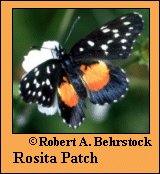 |
 

 |



Rosita Patch (Chlosyne rosita Hall)
Wing span: 1 7/16 - 1 11/16 inches (3.7 - 5 cm).
Identification: Both surfaces of forewing are black with white spots. Upperside of hindwing is black; basal patch is red-orange with yellow at the base.
Life history: Eggs are laid on the underside of host plant leaves.
Flight: Many flights, throughout most of the year, in South Texas.
Caterpillar hosts: Several plants in the acanthus family.
Adult food: Flower nectar.
Habitat: Subtropical forest openings.
Range: El Salvador north to Mexico. Periodic colonist in the lower Rio Grande Valley of South Texas; rare stray to northern Texas and southeastern Arizona.
Conservation: Not usually required.
The Nature Conservancy Global Rank: G4 - Apparently secure globally, though it might be quite rare in parts of its range, especially at the periphery.
Management needs: Provide host plant patches in refuges and parks along the lower Rio Grande Valley, Texas.
References:
Opler, P. A. and V. Malikul. 1992. A field guide to eastern butterflies. Peterson
field guide #4. Houghton-Mifflin Co., Boston. 396 pages, 48 color plates.
Scott, J. A. 1986. The butterflies of North America. Stanford University Press,
Stanford, Calif. 583 pages, 64 color plates.
Author: Jane M. Struttmann

